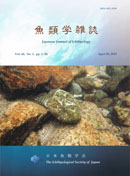Volume 64, Issue 2
Displaying 1-18 of 18 articles from this issue
- |<
- <
- 1
- >
- >|
Original Papers
-
2017 Volume 64 Issue 2 Pages 95-105
Published: November 25, 2017
Released on J-STAGE: June 19, 2018
Download PDF (2893K) -
First Japanese record of Acanthopagrus taiwanensis (Perciformes: Sparidae) from Kagoshima Prefecture2017 Volume 64 Issue 2 Pages 107-112
Published: November 25, 2017
Released on J-STAGE: June 19, 2018
Download PDF (681K) -
2017 Volume 64 Issue 2 Pages 113-119
Published: November 25, 2017
Released on J-STAGE: June 19, 2018
Download PDF (2663K) -
2017 Volume 64 Issue 2 Pages 121-129
Published: November 25, 2017
Released on J-STAGE: June 19, 2018
Download PDF (743K) -
2017 Volume 64 Issue 2 Pages 131-138
Published: November 25, 2017
Released on J-STAGE: June 19, 2018
Download PDF (763K) -
2017 Volume 64 Issue 2 Pages 139-143
Published: November 25, 2017
Released on J-STAGE: June 19, 2018
Download PDF (427K) -
2017 Volume 64 Issue 2 Pages 145-156
Published: November 25, 2017
Released on J-STAGE: June 19, 2018
Download PDF (916K) -
2017 Volume 64 Issue 2 Pages 157-170
Published: November 25, 2017
Released on J-STAGE: June 19, 2018
Download PDF (817K) -
2017 Volume 64 Issue 2 Pages 171-174
Published: November 25, 2017
Released on J-STAGE: June 19, 2018
Download PDF (490K) -
2017 Volume 64 Issue 2 Pages 175-178
Published: November 25, 2017
Released on J-STAGE: June 19, 2018
Download PDF (383K) -
2017 Volume 64 Issue 2 Pages 179-184
Published: November 25, 2017
Released on J-STAGE: June 19, 2018
Download PDF (683K)
Notes
-
2017 Volume 64 Issue 2 Pages 185-189
Published: November 25, 2017
Released on J-STAGE: June 19, 2018
Download PDF (495K) -
2017 Volume 64 Issue 2 Pages 191-193
Published: November 25, 2017
Released on J-STAGE: June 19, 2018
Download PDF (463K) -
2017 Volume 64 Issue 2 Pages 195-199
Published: November 25, 2017
Released on J-STAGE: June 19, 2018
Download PDF (424K) -
2017 Volume 64 Issue 2 Pages 201-205
Published: November 25, 2017
Released on J-STAGE: June 19, 2018
Download PDF (559K) -
2017 Volume 64 Issue 2 Pages 207-211
Published: November 25, 2017
Released on J-STAGE: June 19, 2018
Download PDF (638K)
Series
-
2017 Volume 64 Issue 2 Pages 213-218
Published: November 25, 2017
Released on J-STAGE: June 19, 2018
Download PDF (613K) -
2017 Volume 64 Issue 2 Pages 218-223
Published: November 25, 2017
Released on J-STAGE: June 19, 2018
Download PDF (618K)
- |<
- <
- 1
- >
- >|
